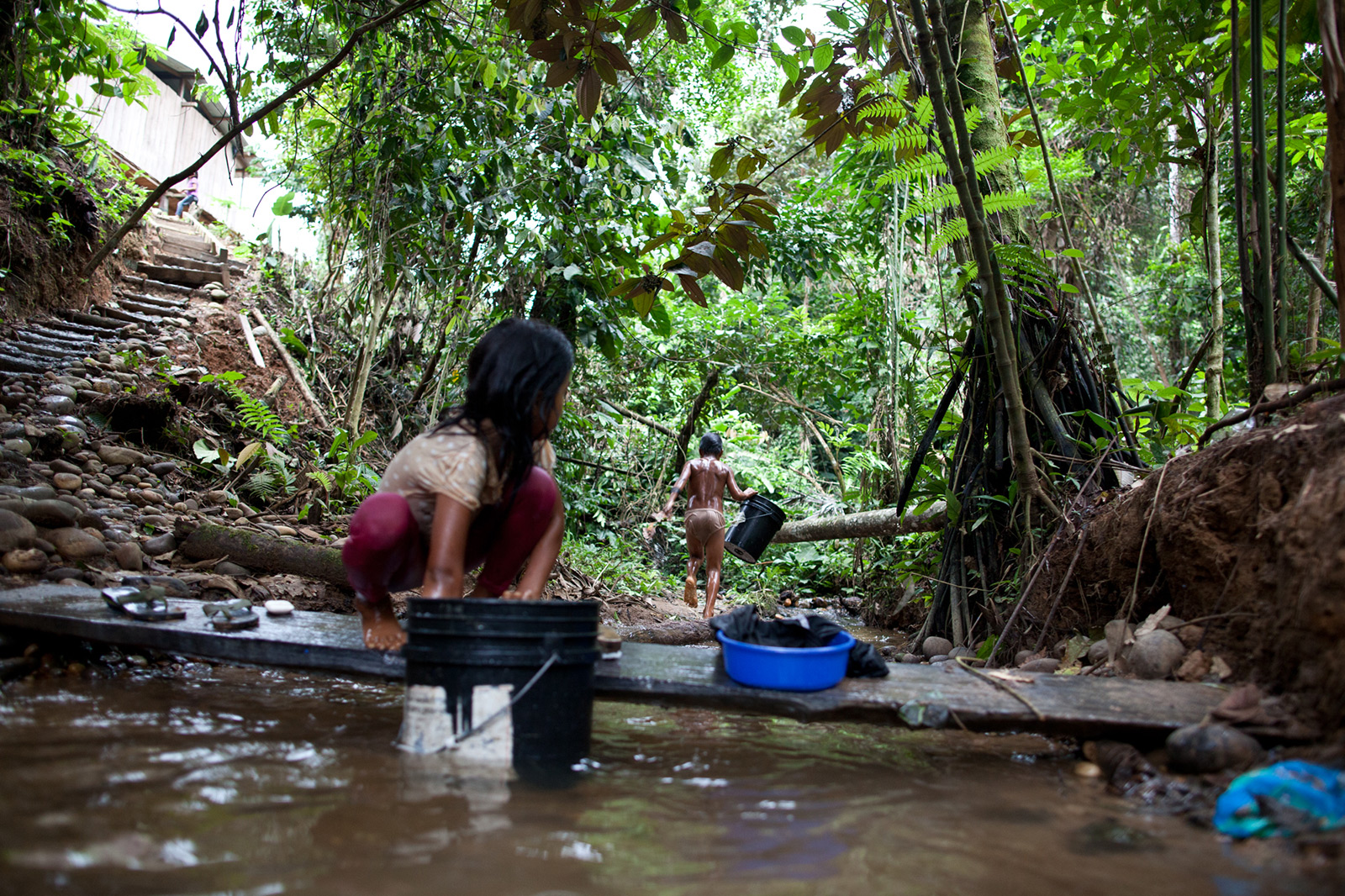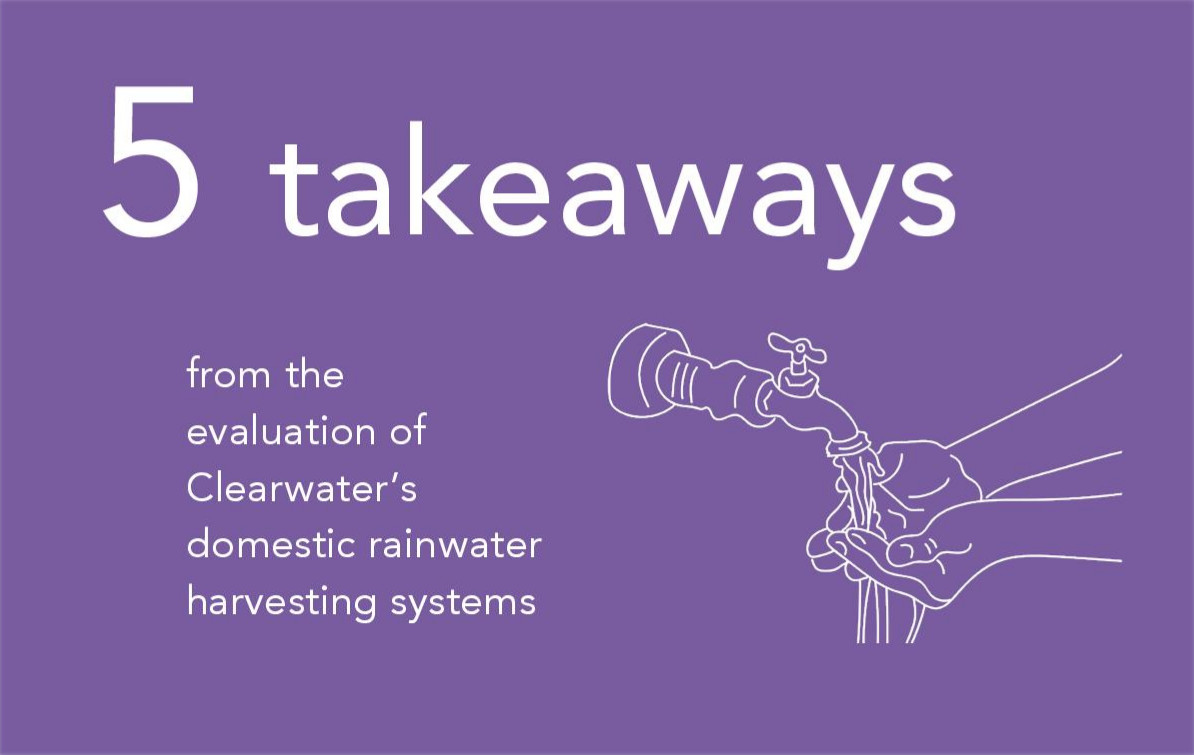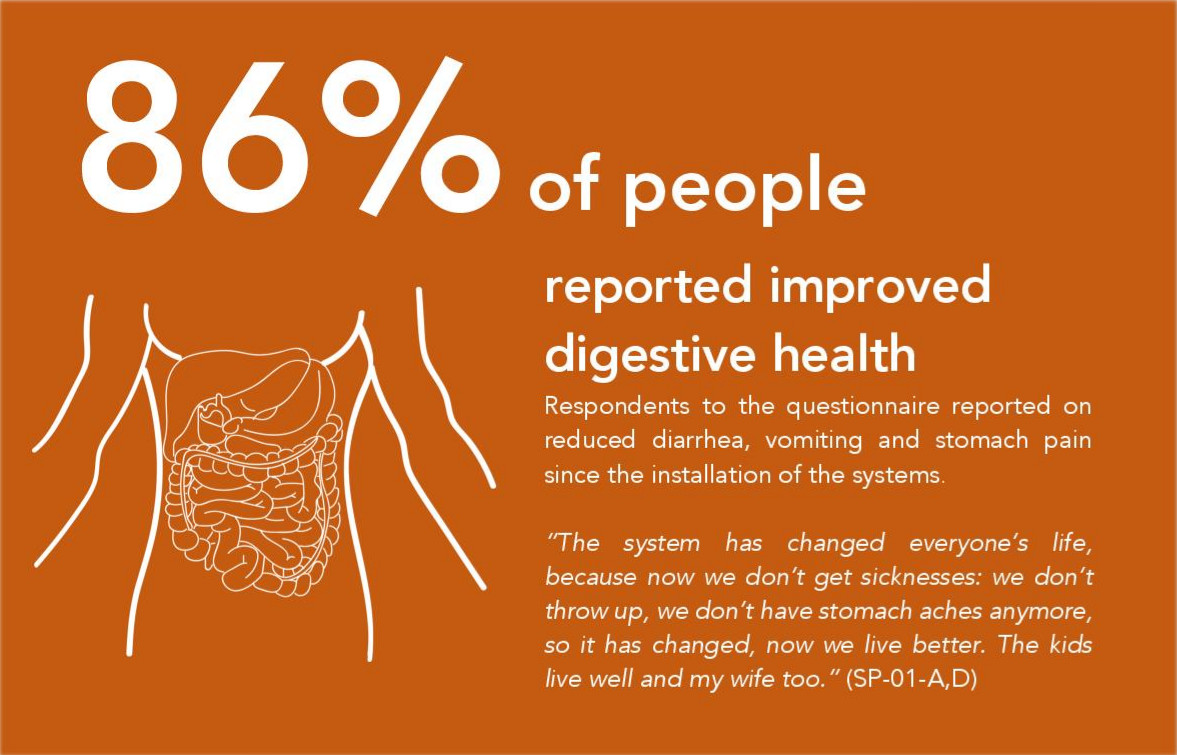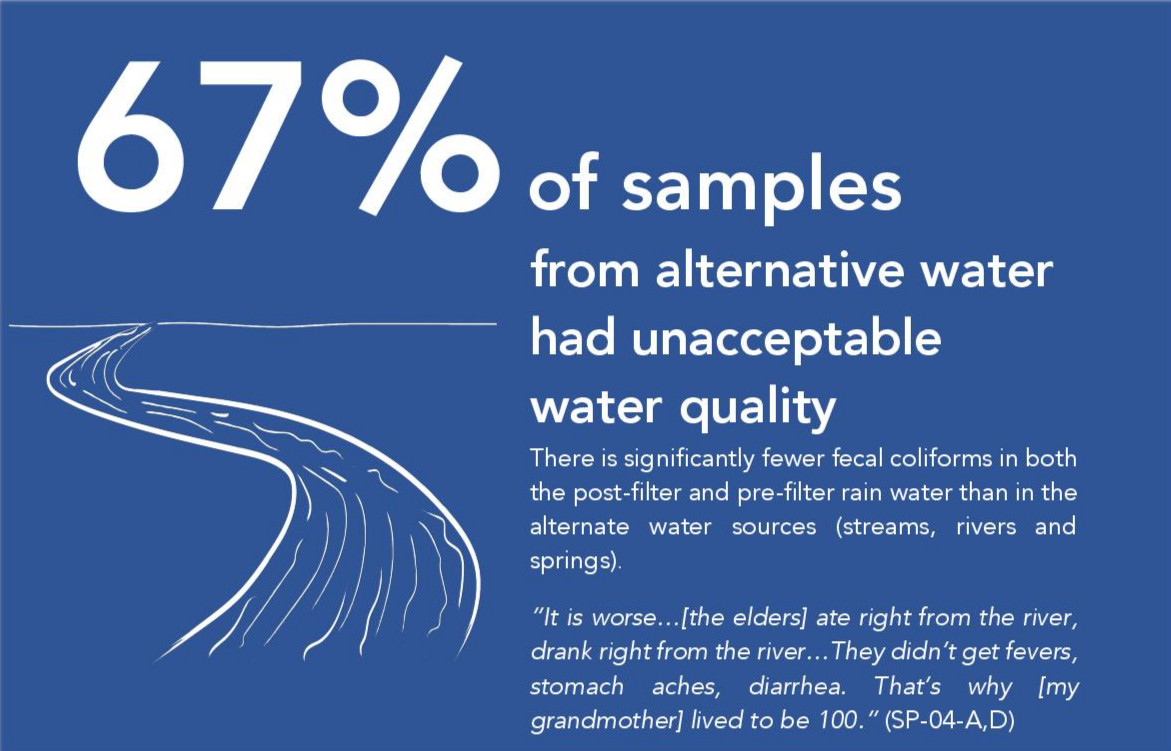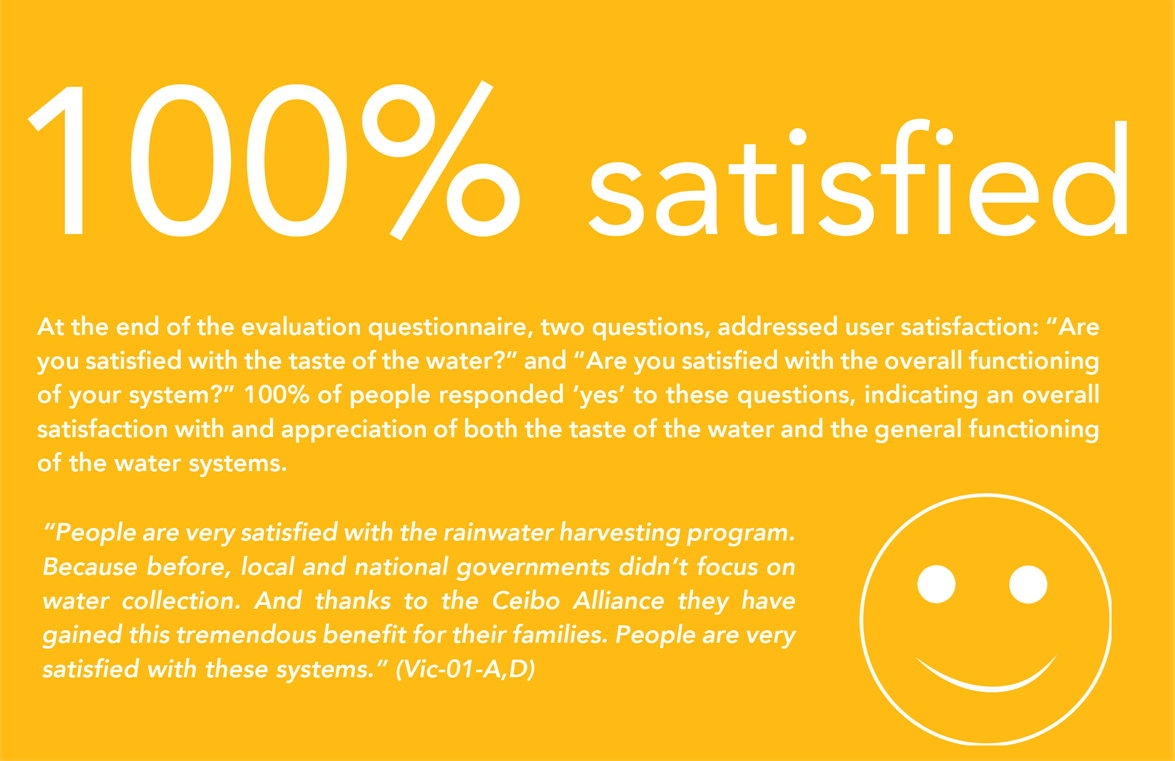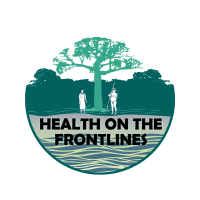
For many of you who are reading this Chronicle, access to potable water, directly into your home, is a given. For most people in the world, though, this simply is not the case. In fact, according to the United Nations billions of people live without access to safe water. Billions. Among them are the indigenous communities of the Ecuadorian Amazonian rainforest where, despite the fact that water abounds, the rivers and streams have been nearly ubiquitously contaminated by oil, rendering the once pristine waters undrinkable. At the same time, ballooning population combined with inadequate sanitation has led to a rise in parasites carried by water.
From 2012 to 2018, Amazon Frontlines and its partner organization Ceibo Alliance provided domestic rainwater harvesting systems to 1164 households in 78 communities of the Northeastern Ecuadorian Amazon benefiting over 6000 people living downriver from the oil fields. In this Chronicle, we will learn more about the water-related health problems that indigenous people in the Amazon face and how domestic rainwater harvesting systems are helping.
Tainting the Amazon’s surface water
In the period from 2005 to 2015 alone, oil companies released over 350,000 barrels of crude oil into the rivers, streams and soils of the Ecuadorian Amazon, amounting to an average of 4000 barrels of a toxic chemical mix, including heavy metals and polycyclic aromatic hydrocarbons, released every day into the environment. Some hydrocarbons are known carcinogens (IARC, 2015). A study in an oil-producing region of Peru examined nearly 3000 river water samples and found that a significant number of them did not meet Peruvian water quality standards for a variety of metals. The authors conclude, “that spillage of produced water in Peruvian Amazon rivers placed at risk indigenous population and wildlife during several decades. Furthermore, the impact of such activities in the headwaters of the Amazon extended well beyond the boundaries of oil concessions and national borders, which should be taken into consideration when evaluating large scale anthropogenic impacts in the Amazon” (Yusta-García 2017, abstract).

Co-founders of the Ceibo Alliance show evidence of oil contamination in the northern Ecuadorian Amazon. From left to right: Alicia Salazar of the Siona nation, Nemonte Nenquimo of the Waorani nation, and Flor Tangoy of the Siona nation.
Concurrently, African palm plantations have led to the deforestation of an equivalent of 100 000 soccer fields and the use of a large quantity of pesticides and fertilizers, some of which end up in the local waterways. Some pesticides are considered probable carcinogens (IARC, 2015).
Over the past half-century, the Ecuadorian Amazon has been crisscrossed by more than 9500 km of roads – or 1.5 times the Earth’s radius – built to connect the more than 3430 oil wells to market via pipeline. The construction of a proposed road in a remote region of the Peruvian Amazon was found to have disproportionately negative impacts on the drinking water quality (sediment retention and nitrogen and phosphorus regulation) of nearby indigenous communities (Mandel et al. 2015).
Access roads entice colonists to set up small farms, resulting in the deforestation of vast tracts of land. Amazonian soils contain large amounts of naturally occurring mercury, accumulated there over centuries of nearby volcanic activity (Mainville et al. 2006). Mercury exists in the soils in a harmless form, but once soils erode into waterways following deforestation, the mercury is converted into a toxic form, easily entering the aquatic food chain and humans via fish consumption (Webb et al. 2004). Illegal gold mining, booming in certain areas of the Amazon, can also be an important source of mercury to aquatic ecosystems (Akagi et al., 1995).
From Pristine to Parasite-infested
Sipping your chlorinated water, fresh from the tap, you might think, “Who would drink straight from the river?” Yet, for millennia, this was the main source of water in the Amazon and it supported thriving civilizations. However, nowadays, the water is teeming with harmful microscopic life that your eyes can’t see but that your intestines detect. Studies show that the current high parasite levels are not the baseline for Amazonian waterways.
Several early studies conducted in the 1980s, just as the population of the Ecuadorian Amazon was exploding, show that the indigenous people, who had no other source of water than the same streams and rivers that their ancestors drank from, had relatively low parasite levels. “Before sustained contact, the Huaorani had practically no intestinal parasites due to drinking from feeder streams with headwaters rarely visited by outsiders; however, within 3 years of contact their parasite loads were nearly equal to those of neighboring groups” (Davis and Yost, 1983 in Houck et al., 2013).
Benefice et al. (1990) showed that parasitic infestation rates among settlers were significantly higher than in the Siona-Secoya communities and attributed this partly to the readily available and good quality water running through indigenous communities.
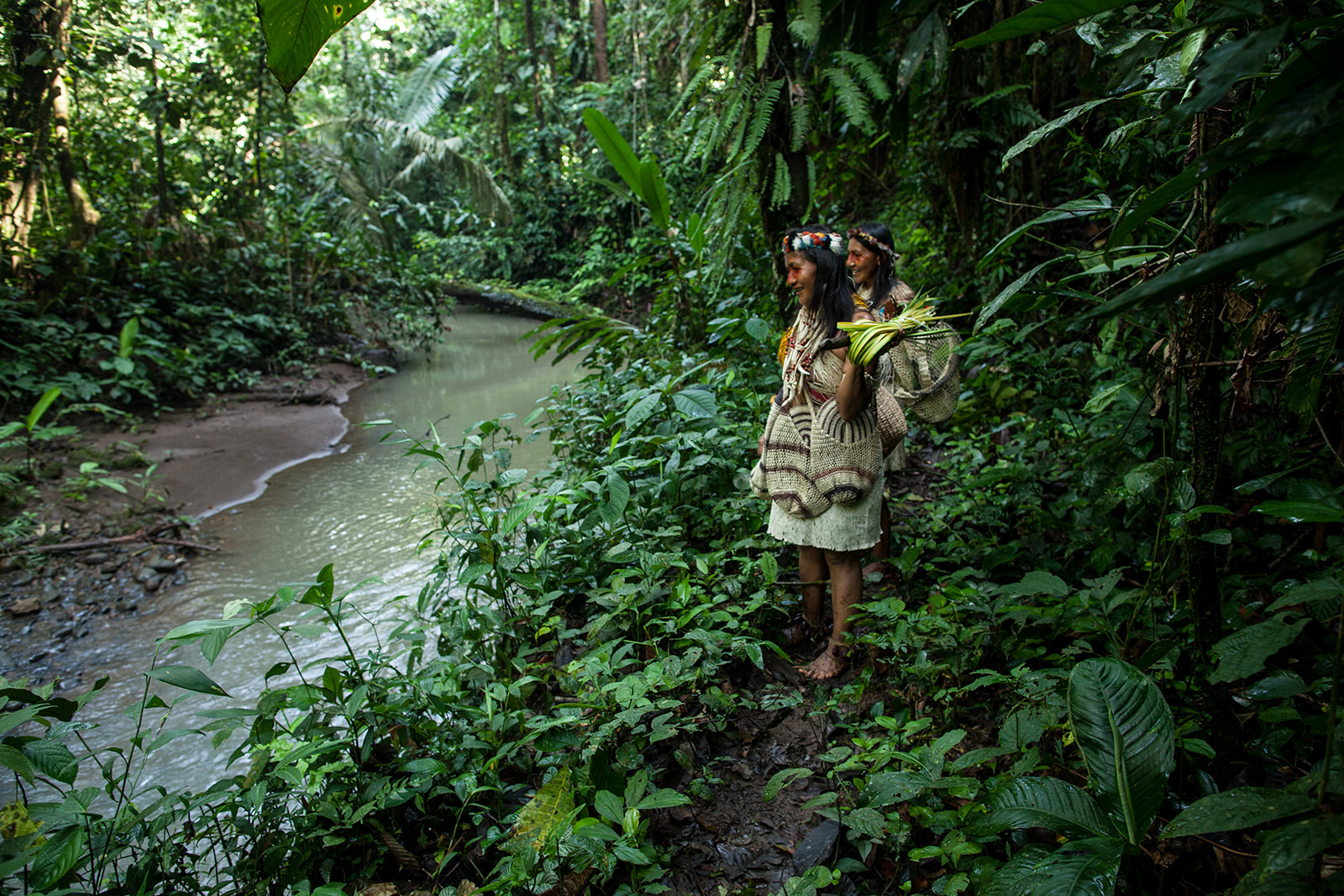
Waorani women in their ancestral territory, Pastaza Province, Ecuadorian Amazon
A recent study conducted in Bolivia found that the Tsimane’ people appear to adapt to poor water quality by eating more fruit (Rosinger and Tanner, 2015). They found that 50% of their total water intake came from fruit and that each percent increase in water consumed from food was associated with a decrease in gastrointestinal illness. “Both total water intake and percentage of water from foods were higher than averages in industrialized countries. These findings suggest that people without access to clean water may rely on water-rich foods as a dietary adaptation to reduce pathogen exposures” (Rosinger and Tanner, 2015; abstract). Unfortunately, some of the same processes that are leading to deteriorating water quality are also reducing people’s access to flourishing forests and their succulent produce.
Amazonian ecosystems had their own mechanisms for keeping parasite levels low. The problem has arisen recently primarily because of swelling population levels and inadequate sanitation. The ecosystem has quite simply become overloaded with feces. At the same time, current land-use practices are diminishing the ecosystem’s ability to rid water of existing parasites. Healthy forests, intact soils and rich decomposer biodiversity can provide physical barriers to substances that hold high levels of parasites from getting into waterways. Without them, parasites can get the upper hand. Additionally, a recent paper has shown that coliforms, and potentially other harmful water-borne pathogens, proliferate in the presence of hydrocarbons (Khanafer et al. 2017).
Climate change is leading to flooding in certain regions and drought in others. Both affect water security. In Bolivia, it was found that incidence of diarrhea related to pathogens in the the water roughly doubled following a historic flood in 2014 (Rosinger 2017). Floods sweep away domestic animals and wildlife contaminating river water, while overflowing rivers seep into otherwise clean underground water sources.
In 2016, water, sanitation and hygiene (WSH) was responsible for 1.9% of the global burden of disease. The latest data available for Ecuador estimates the total WSH-related deaths at 88,200, or 3.9% of the deaths in 2004. In 2015, over 2 million Ecuadorians did not have access to improved water. Chronic diarrhea, especially in children, can lead to malnutrition (Buitron et al. 2004). Treatments for stomach complaints can sap scarce economic resources from families with limited revenue, forcing them to work longer hours, go without other essentials or exploit natural resources.
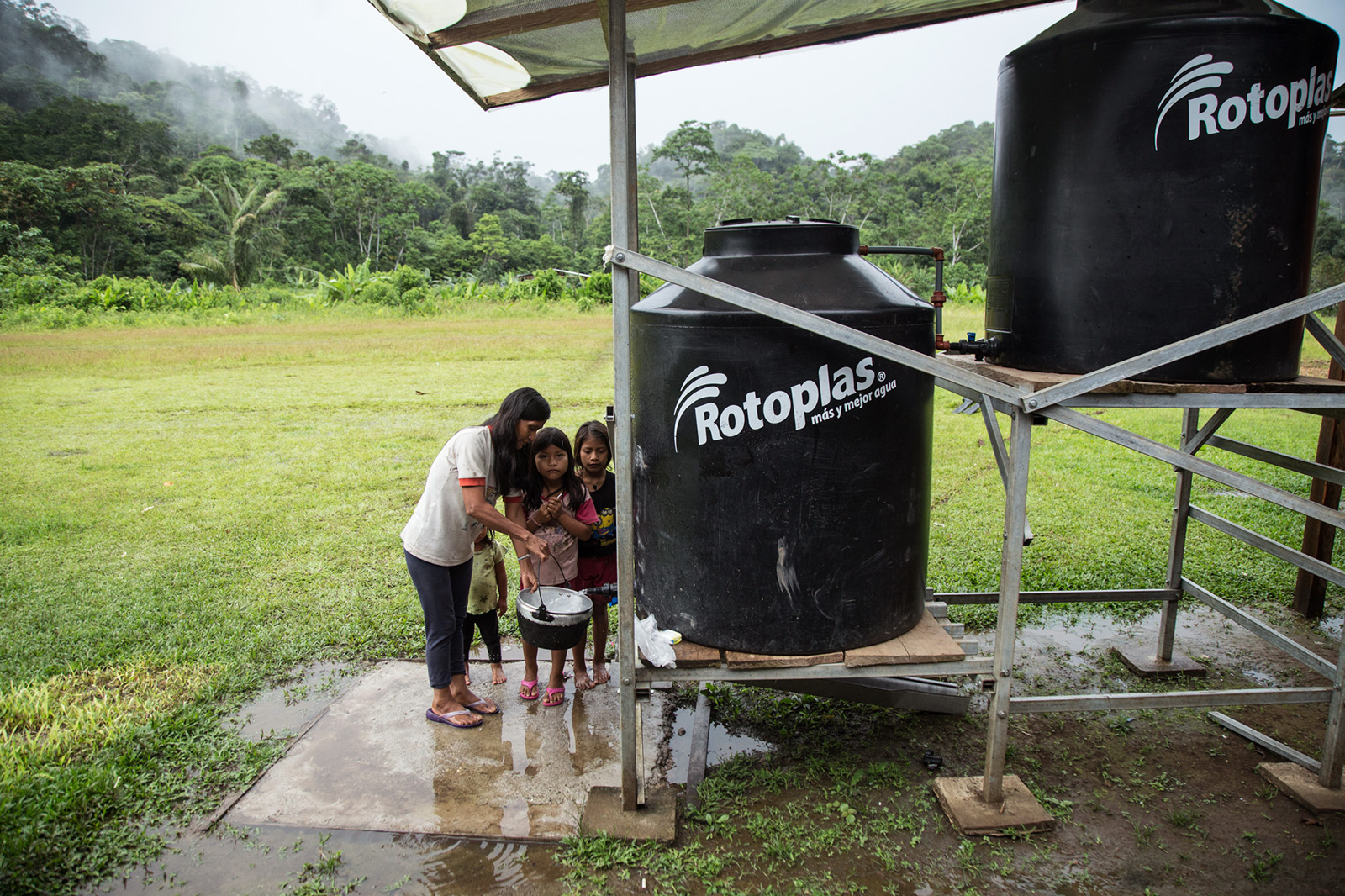
A woman and her children collect water from her home’s rainwater harvesting system in a Waorani community, Ecuadorian Amazon
Provisioning Water from Rain
The United Nations named access to clean drinking water a basic human right in 2010. In that same year, 89 million people across the globe depended on rainwater as their main supply (WHO and UNICEF, 2012). Rainwater is largely free of impurities (World Health Organization, 2008). When properly installed and managed, Domestic Rainwater Harvesting (DRWH) Systems are considered inexpensive and low-tech; and vastly superior to most alternatives, such as surface water. Bearing in mind the benefits of rainwater harvesting, expanding capacity in developing countries has been set as a new World Health Organization goal (6.a) (WHO and UNICEF, 2017; p.7).
Most studies have reported levels below maximum permissible concentrations for metals, hydrocarbons and pesticides in rain-harvested water (Abbasi & Abbasi, 2011). Women in the Amazon who use surface water were found to have twice the amount of mercury and hydrocarbons in their urine as women who use rainwater (Webb et al. 2016; 2017).
Considering the abundance of rain in the Amazon and deteriorating water quality as a result of industrial extraction processes and demographic changes, Amazon Frontlines and the Ceibo Alliance, along with our partners Rainforest Fund and Saving an Angel, designed a water provisioning project based on the installation of domestic rainwater harvesting systems. Over the past seven years, the ClearWater project has provided clean and free drinking water to indigenous peoples of the Kofan, Secoya, Siona, and Waorani nations in the Ecuadorian Amazon, one of the world’s most infamous oil-related disaster areas.
In order to ensure that the 6000-plus people serviced by ClearWater’s rainwater harvesting systems were indeed benefiting from the water provided by the ClearWater project, we conducted an evaluation of water quality, integrating observations from in-depth interviews with users in the indigenous communities.
Here are some of the most important findings:
· Drinking water samples had no detectable levels of polycyclic aromatic hydrocarbons (PAHs) or heavy metals such as mercury and lead.
· 86% of people reported improved digestive health (reduced diarrhea, vomiting and stomach pain) since the installation of the systems.
· 85% of systems had ideal water quality as indicated by fecal coliform levels.
· Water from alternative sources (rivers, streams and springs) had significantly lower water quality as indicated by high levels of fecal coliform.
· One hundred percent of the respondents were satisfied with the taste of the water and the functioning of their system.
The qualitative analysis showed a high level of satisfaction with the water and the systems. Comments pointed to improvements in health and workload, with the system reducing the number of hours and the effort required to collect water. This is especially crucial with respect to women’s work, health and well-being as this task most often falls to women and girls. World-wide, eight out of ten households in which water is off-premises rely on women and girls to carry out the difficult, and sometimes dangerous, task of water collection. In the water security study carried out in the Bolivian Amazon, 24% of women (compared to only 7% of men) reported having been injured in the month prior while fetching water (Rosinger 2018).
So, now 1164 households in 78 communities of the Ecuadorian Amazon also have running water, right at their kitchen door, thanks to the ClearWater project. This water contains no chlorine, but the vast majority of it is just as clean as that coming out of the faucet in any home in a developed nation. Clean drinking water is the most fundamental of basic needs and a prerequisite for thriving and resilient communities. Our hope in conducting this project has been to contribute to these communities’ wellbeing and their capacity to defend their forest homes. Our hope in communicating about the evaluation is to build out solutions and lessons for other indigenous villages affected by oil and water of sub-standard quality on how to construct rainwater harvesting systems and maintain them. As oil companies continue to push further into the forest, this urgent work continues both here in the Ecuadorian Amazon and elsewhere.
Find out more about this powerful indigenous-led and community-based project, and join the movement for a healthy future in the Amazon.
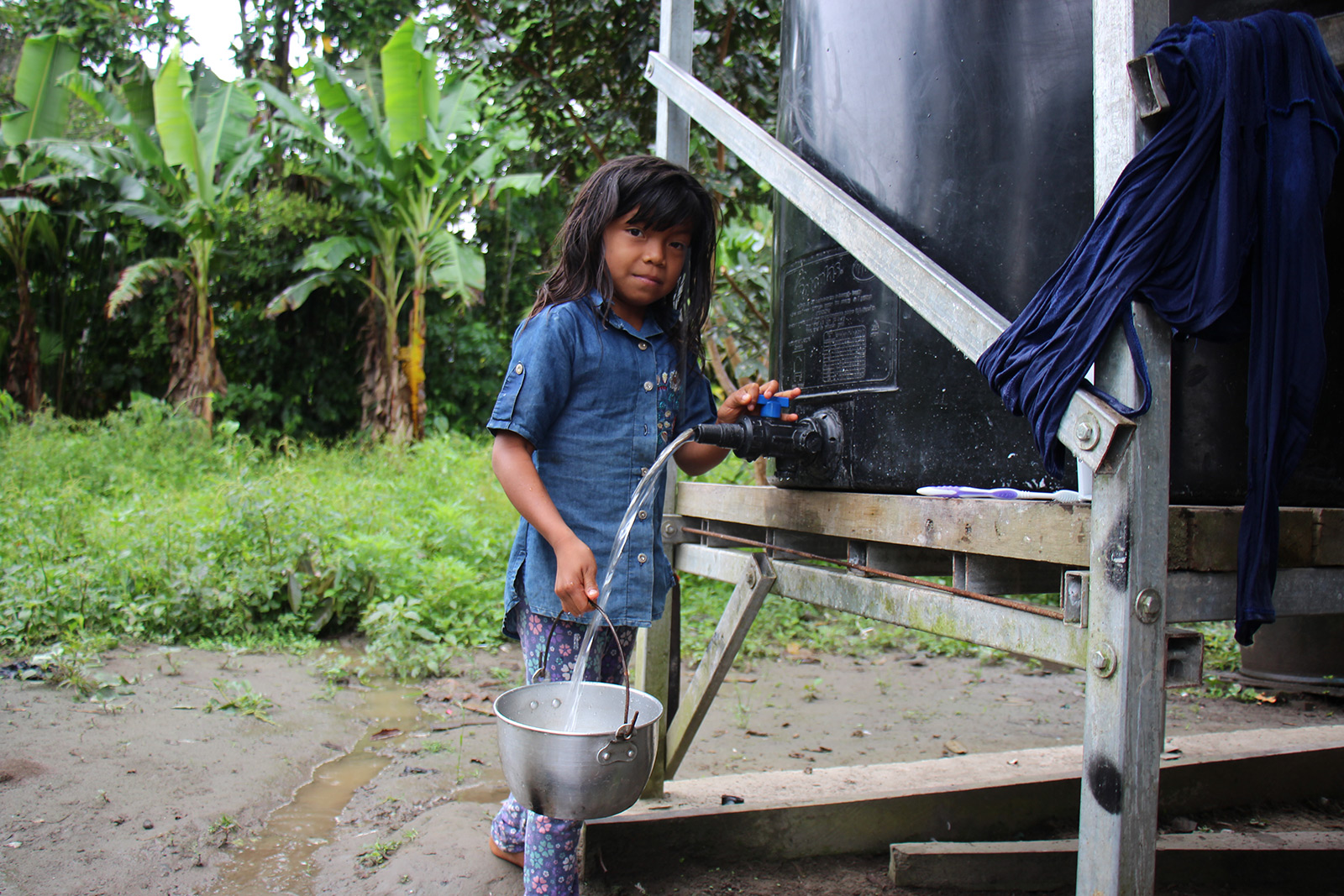
A young girl collects water from her home’s rainwater harvesting system in the Kofan community of Upiritu, Ecuadorian Amazon
References
- Abbasi, T. and S. A. Abbasi (2011). “Sources of pollution in rooftop rainwater harvesting systems and their control.” Critical Reviews in Environmental Science and Technology 41(23): 2097-2167. https://www.tandfonline.com/doi/abs/10.1080/10643389.2010.497438
- Akagi, H., O. Malm, Y. Kinjo, M. Harada, F. J. P. Branches, W. C. Pfeiffer and H. Kato (1995). “Methylmercury pollution in the Amazon, Brazil.” Science of The Total Environment 175(2): 85-95.https://www.sciencedirect.com/science/article/pii/0048969795049053
- Buitron, D., A. Hurtig and M. San Sebastian (2004). “Nutritional status of Naporuna children under five in the Amazon region of Ecuador.” Rev Panam Salud Publica 15(3): 151-159. https://www.scielosp.org/scielo.php?script=sci_arttext&pid=S1020-49892004000300003&lang=en
- Davis, E. W. and J. A. Yost (1983). “The ethnomedicine of the waorani of Amazonian Ecuador.” Journal of Ethnopharmacology 9(2): 273-297. https://www.sciencedirect.com/science/article/pii/0378874183900363
- Houck, K., V. Sorensen Mark, F. Lu, D. Alban, K. Alvarez, D. Hidobro, C. Doljanin and I. Ona Ana (2013). “The effects of market integration on childhood growth and nutritional status: The dual burden of under‐ and over‐nutrition in the Northern Ecuadorian Amazon.” American Journal of Human Biology 25(4): 524-533. https://onlinelibrary.wiley.com/doi/abs/10.1002/ajhb.22404
- International Agency for Research on Cancer (IARC). Agents Classified by the IARC Monographs, Volumes 1 – 114. 2015. https://monographs.iarc.fr/agents-classified-by-the-iarc/
- Khanafer, M., H. Al-Awadhi and S. Radwan (2017). “Coliform Bacteria for Bioremediation of Waste Hydrocarbons.” BioMed research international 2017: 1838072-1838072. https://www.hindawi.com/journals/bmri/2017/1838072/
- Mainville, N., J. Webb, M. Lucotte, R. Davidson, O. Betancourt, E. Cueva and D. Mergler (2006). “Decrease of soil fertility and release of mercury following deforestation in the Andean Amazon, Napo River Valley, Ecuador.” Science of the Total Environment 368: 88-98. https://www.sciencedirect.com/science/article/pii/S0048969705006546
- Mandle, L., H. Tallis, L. Sotomayor and A. L. Vogl (2015). “Who loses? Tracking ecosystem service redistribution from road development and mitigation in the Peruvian Amazon.” Frontiers in Ecology and the Environment 13(6): 309-315. https://esajournals.onlinelibrary.wiley.com/doi/abs/10.1890/140337
- Rosinger, A. and S. Tanner (2015). “Water from fruit or the river? Examining hydration strategies and gastrointestinal illness among Tsimane’ adults in the Bolivian Amazon.” Public Health Nutrition 18(6): 1098-1108. https://www.cambridge.org/core/journals/public-health-nutrition/article/water-from-fruit-or-the-river-examining-hydration-strategies-and-gastrointestinal-illness-among-tsimane-adults-in-the-bolivian-amazon/96F7D9B8716DC45553D8CBC0B4122C11
- Rosinger, A. Y. (2018). “Household water insecurity after a historic flood: Diarrhea and dehydration in the Bolivian Amazon.” Social Science & Medicine 197: 192-202. https://www.sciencedirect.com/science/article/abs/pii/S0277953617307463?via%3Dihub
- Webb, J., N. Mainville, D. Mergler, M. Lucotte, O. Betancourt, R. Davidson, E. Cueva and E. Quizhpe (2004). “Mercury in fish-eating communities of the Andean Amazon, Napo River Valley, Ecuador.” EcoHealth 1(suppl. 2): 59-71. https://link.springer.com/article/10.1007/s10393-004-0063-0
- Webb, J., O. T. Coomes, D. Mergler and N. Ross (2016). “Mercury Concentrations in Urine of Amerindian Populations Near Oil Fields in the Peruvian and Ecuadorian Amazon.” Environmental Research 151: 344-350. https://www.sciencedirect.com/science/article/pii/S0013935116303279
- Webb, J., O. T. Coomes, D. Mergler and N. A. Ross (2017). “Levels of 1-hydroxypyrene in urine of people living in an oil producing region of the Andean Amazon (Ecuador and Peru).” International Archives of Occupational and Environmental Health 91(1): 105-115. https://link.springer.com/article/10.1007%2Fs00420-017-1258-3
- World Health Organization. (2008) Rainwater Harvesting. Chapter 6.11 In: Guidelines for Drinking-water Quality, Second Addendum to the 3rd Edition. Geneva. https://www.who.int/water_sanitation_health/dwq/fulltext.pdfWorld Health Organization (WHO) and the United Nations Children’s Fund (UNICEF) (2012) Progress on drinking water and sanitation. 2012 Update WHO/UNICEF Joint Monitoring Programme for Water Supply and Sanitation. Geneva. https://reliefweb.int/report/world/progress-drinking-water-and-sanitation-2012
- World Health Organization (WHO) and the United Nations Children’s Fund (UNICEF) (2017) Progress on Drinking Water, Sanitation and Hygiene: 2017 Update and SDG Baselines. Geneva. https://www.unicef.org/publications/index_96611.html
- Yusta-García, R., M. Orta-Martínez, P. Mayor, C. González-Crespo and A. Rosell-Melé (2017). “Water contamination from oil extraction activities in Northern Peruvian Amazonian rivers.” Environmental Pollution 225: 370-380. https://www.sciencedirect.com/science/article/pii/S0269749116321674?via%3Dihub


